South & West Yorkshire
Careless of local opinion, the bureaucrats have been interfering with the boundaries of Yorkshire for so long that we can take a few liberties of our own. For convenience we have combined South and West Yorkshire, most of which was formerly the West Riding. The city of York has been put with the East Riding and North Yorkshire remains as a separate county.
HAWORTH
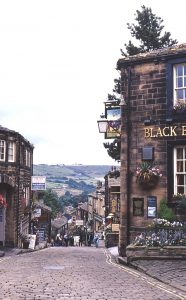
Haworth Main Street
Located between the Leeds-Bradford conurbation and barren Pennine moorland, the village will for ever be associated with the talented but tragic Bronte sisters. The Rev. Patrick Bronte was vicar here for forty-one years from 1820 and outlived all of his six children, including the literary trio of Charlotte, Emily and Anne. Apart from Anne, who died at Scarborough, all the family lie within a vault in the church. Following signs to the Bronte Village, tourists come in their thousands to amble up and down the steep cobbled Main Street, sipping tea in the cafes and browsing in the souvenir shops.
We come here in search of one of Patrick Bronte's predecessors, William Grimshaw (1708-1763), who served the parishioners of Haworth two generations earlier. Grimshaw belonged to that group of eighteenth century clergy whose zeal and fervour earned them the nickname of Methodists, but who never envisaged separation from the Church of England.
Ordained in 1731, Grimshaw spent some years as curate at Todmorden, where he was careless of his duties and spent much of his time hunting, shooting and card-playing with the local gentry. Shortly before he moved to Haworth, a series of events - his wife's death, parishioners' questions and reading John Owen's Justification by Faith - brought about a profound spiritual change. When he was appointed perpetual curate of Haworth in 1742, the church had barely a dozen regular communicants, but within a year, the number was close to a thousand, and thirty-five bottles of wine were needed for a single communion service.
Apart from the tower, the church of St Michael and All Angels (BD22 8DR) was completely rebuilt in the late nineteenth century, but there are still reminders of Grimshaw's time here. In the Bronte chapel is his wooden communion table and the brass candelabra is inscribed with his name and favourite text - For me to live is Christ, to die is gain. For some reason, Grimshaw's font (also inscribed with his name) is in the churchyard. A look at some of the gravestones reveals that the misfortunes of the Bronte family were by no means exceptional. Haworth was an unhealthy place, with a poor water supply and subject to frequent bouts of plague - probably typhus. With four of the six Bronte children reaching adulthood, they probably fared better than most. Grimshaw lost his first wife (and great love) Sarah after less than five years' marriage, and his second, Elizabeth, after a similar time. He himself died of typhus at the age of fifty-five.

Sowden's Farm, Haworth
The Bronte Parsonage Museum, much visited by tourists on their literary pilgrimage, was not Grimshaw's home. He lived at Sowdens Farm, about ten minutes walk from the church. Follow the flagged path to the kissing gate at the far end of the churchyard and continue along the narrow track between the stone walls. The comfortably-sized stone farmhouse can be seen over the wall or from the front entrance, but is privately owned. It carries a plaque recording that among Grimshaw's visitors were John and Charles Wesley, George Whitefield, John Newton and Henry Venn.
The Black Bull pub on the main square has a plaque recalling that it was one of the drinking dens of the dissolute Bronte brother, Branwell. In Grimshaw's time, a visitor one Sunday noticed men jumping out of its windows and over a wall. Thinking there was a fire, he went to investigate but was told that the men had seen the parson coming with a whip to chase them into church for the sermon! Grimshaw did not oppose the pub on principle - it was run by his parish clerk and his guests often stayed there - but he did not shrink from using firm discipline to remind his flock of their spiritual duties. He himself had a dramatic vision while recovering in the Black Bull's parlour after fainting in church, which spurred him on to further evangelistic efforts.
The Methodist Chapel in West Lane was built by Grimshaw in 1758. As mentioned, there was no thought of separation at this time, but he wanted to ensure that the purer part of the congregation was provided for in case his successors were not of the same persuasion as himself.
LUDDENDEN
When William Grimshaw died in 1763, he was buried next to his first wife Sarah, in the chancel of St Mary's Church (HX2 6PX) where there is a brass memorial plaque. The funeral sermon was preached by Henry Venn of Huddersfield. The village lies in a deep Pennine valley a few miles south of Haworth, with the church standing by the river close to a weir.
HUDDERSFIELD
Henry Venn (1724-1797) was vicar of St Peter's Church (HD1 1BU), on the corner of Kirkgate and Lord Street, from 1759 to 1771. He was among the small number of parish clergy who were steadfast supporters of the ministry of John Wesley and George Whitefield and was author of a popular work called The Complete Duty of Man. He was also the founding father of an evangelical dynasty, which included his son John, leader of the Clapham Sect and his granddaughter Charlotte Elliott, author of the hymn Just as I am.
Venn's building was replaced by the present church in the 1830s, but a marble tablet on the north wall records that in a dark day for the church Venn was a shining light to the people of the town. He preached a dozen times a week, organizing his converts into classes and, despite spending only twelve years here, brought about a profound change in the moral and spiritual climate. Eventually ill-health and the death of his wife caused him to find a less onerous ministry at Yelling in Cambridgeshire.
PUDSEY

James Mongomery statue, Sheffield
On the southern edge of Pudsey, overlooking a steep wooded valley is the Moravian settlement of Fulneck (LS28 8NT). The community was founded in 1743 and took its name from a town in Germany, home of the original settlers. Today, the work continues with the church, school and houses arranged in an irregular line along a paved walkway below the road. The most famous alumnus was the poet, hymn writer and journalist James Montgomery (1771-1854), but a plaque on one of the houses records that Benjamin La Trobe, architect of the White House, was also born here.
A native of Ayrshire in Scotland, Montgomery was sent to school here at the age of six and remained for ten years. His parents - Moravian missionaries - departed for the West Indies in 1783, where they both died. Montgomery began working for the Sheffield Register at the age of twenty-one and eventually became owner and editor of the paper, changing its name to the Sheffield Iris. He spent sixty-two years in his adopted city, active in literary, philanthropic and Sunday School work, and his statue stands on the east side of Sheffield Cathedral (S1 1HA). Several of his hymns, including Stand up and bless the Lord and the carol Angels from the realms of glory, are included in most collections. The Montgomery Performing Arts Centre in Surrey Street also remembers one of the city's most famous sons
FARSLEY
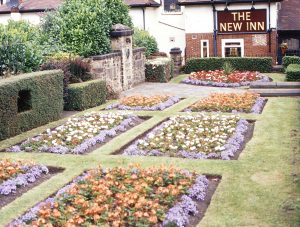
Samuel Marsden memorial garden
Just north of Pudsey and forming a western suburb of Leeds, Farsley was the birthplace of Samuel Marsden (1764-1838), chaplain to the penal colony at Sydney and pioneer missionary to New Zealand. His house in Town Street has gone but there is a neatly kept Memorial Garden (LS28 5SF) on the site and a wall tablet with his portrait in bronze and also that of a sheep!
Encouraged by William Wilberforce, a near contemporary who had attended the same school in Hull, Marsden set out for Australia in 1793 and for the rest of his life was based at Parramatta. The penal settlement was only four years old and Marsden's role also included that of administrator, agricultural pioneer and magistrate. In 1807, he returned to England to report on the state of the colony, bringing with him a consignment of wool. As the memorial records, this was stored in a warehouse here and later made into cloth by a firm near Leeds. When he returned in 1809, he took with him five Merino sheep given by George III, which formed the nucleus of the vast Australian wool industry. Marsden's role as a magistrate was more controversial and he was criticized for the severity of his sentences.
Marsden was interested in the early colonization of New Zealand. He purchased and equipped his own brig, the Active, and landed at the Bay of Islands, thus becoming the first missionary to that country. He preached the first ever sermon there on Christmas Day, 1814.
In the churchyard of St John the Evangelist on the opposite side of Town Street is a granite obelisk in memory of Marsden.
BARNSLEY
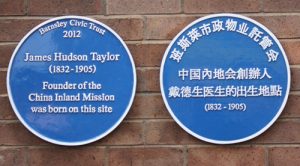
English and Chinese plaques
For a long time there was little in Barnsley to commemorate its most famous son, James Hudson Taylor (1832-1905), founder of the China Inland Mission. Then it was noticed that Chinese Christians were visiting the town, searching for his birthplace. In 2012, a group of local Christians formed the Barnsley Hudson Taylor Group and there is now a James Hudson Taylor Trail to fourteen locations with connections to the pioneer missionary (see www.jameshudsontaylor.org.uk).
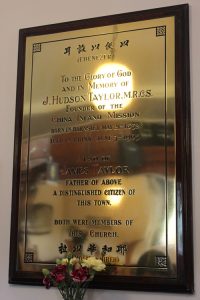
Hudson Taylor memorial
Taylor's birthplace was in Cheapside, the main shopping area, where is father had a pharmacy business. The house has gone but, appropriately, the site is now occupied by a branch of Boots, and carries plaques in English and Chinese (S70 1RT).
Another important location on the trail is Salem Wesleyan Reform Church in Blucher Street, where there is a brass memorial plaque to Taylor, which also mentions his father James Taylor, a distinguished citizen of this town.
HORBURY
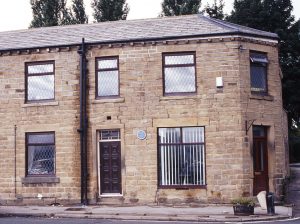
Horbury Bridge mission house
The road signs on the A642 proclaim Horbury as the Home of Onward Christian Soldiers. The story begins at Horbury Bridge where the Rev Sabine Baring Gould (1864-1924) founded a mission hall in the end house of a terrace of cottages in Bridge Road, close to the Horse and Jockey pub (WF4 5PP). The house is marked by a plaque and is currently in use as a hair salon.
Baring Gould was curate at the church of St Peter and St Leonard in Horbury for just two years (1864-66). He composed the well-loved hymn to be sung by the children as they marched up from the mission hall to the mother church for the Sunday School Anniversary at Whitsuntide 1865. In 1872, he inherited estates in Devon, which included the living of Lewtrenchard, where he spent over fifty years as vicar, but will always be remembered for the stirring lines composed during his brief spell in this small Yorkshire town.
AUSTERFIELD
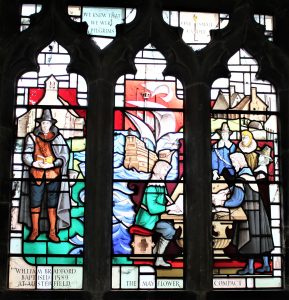
Mayflower window, Austerfield
Aesthetically, the village has little to commend it; even the church is small and unimpressive from the outside. Just across the border from Nottinghamshire, Austerfield consists of mainly modern houses straggling along the A614 for about half a mile. It is remembered as the birthplace in 1589 of William Bradford, Mayflower pilgrim, second governor of the Plymouth colony and one of the founding fathers of America. He also wrote the history of the colony, a journal that was lost for many years before being rediscovered in England in the nineteenth century and returned to the United States. Determined that its place in history should not be forgotten, the village has a Pilgrim Rise, a William Bradford Close and a Mayflower pub.
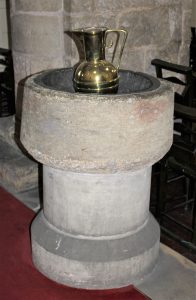
Bradford's baptismal font
St Helena's Church (DN10 6QU), set back from the road, dates from the eleventh century but was extensively restored in Victorian times. Inside there are Norman pillars and arches and in the north aisle a brass plaque, placed by the Society of Mayflower Descendants, records that Bradford was the first American citizen of the English race who bore rule by the free choice of his brethren. Bradford was baptised here on March 19th 1589 and the original font is preserved, having apparently been rescued from a local farmyard many years ago. A stained glass window shows Bradford and the signing of the Mayflower Compact. (See www.pilgrimsandprophets.co.uk)
It is believed that Bradford's home was the Manor House, a substantial white painted house with Tudor half-timbering, just by the bridle path called Low Common Lane, and still privately owned. It was from here that Bradford, as a young lad, would set out each Sabbath on the twelve-mile walk to church at Babworth to sit under the ministry of Richard Clifton. When the Babworth congregation moved to Scrooby, a mere three miles away, it must have helped to save his shoe leather! Bradford's weekly walk would have taken him through the nearby village of Bawtry. This stands on the River Idle, which connects to the Trent and thence to the Humber. From here the women of the Scrooby congregation went by boat to Immingham, when making their escape to Holland in 1608.

Mayflower memorial
Also aboard the Mayflower was William Butten, who sailed as a servant or ordinary seaman and may also have come from Austerfield, although this is unproven. Butten did not share the convictions of the Pilgrims; Bradford regarded him as arrogant and profane. Despite his youth and apparent good health, he was the only person who died during the actual voyage. He is commemorated by Butten Meadow, a close of modern houses with a picture of the famous ship in blue tiles on a wall.


